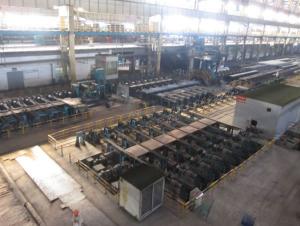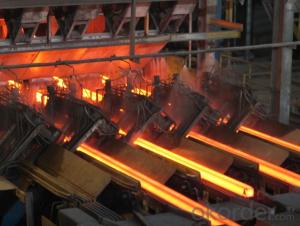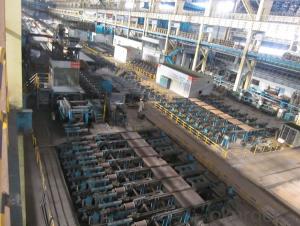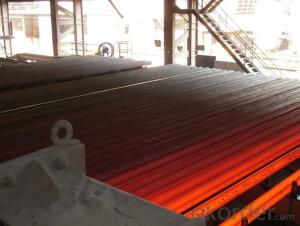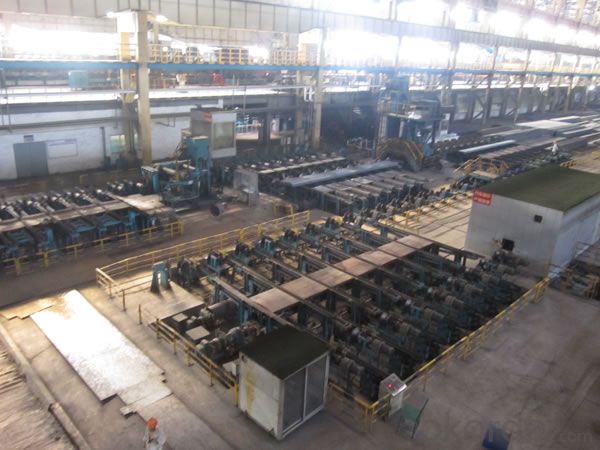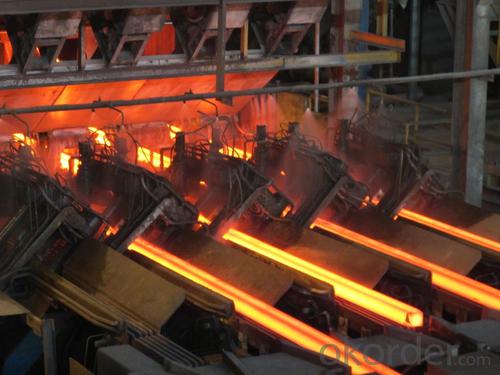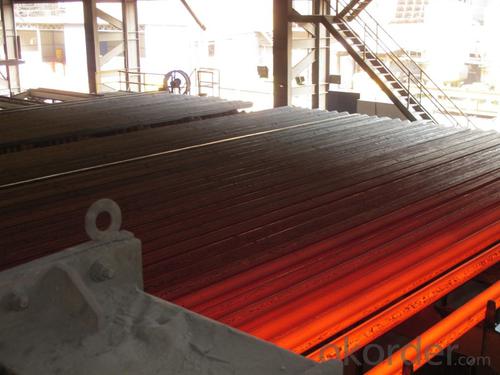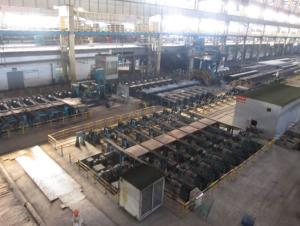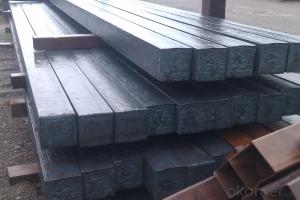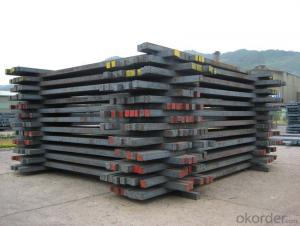Prime quality square alloy steel billet 90mm Q235
- Loading Port:
- Tianjin
- Payment Terms:
- TT OR LC
- Min Order Qty:
- 100 m.t.
- Supply Capability:
- 10000 m.t./month
OKorder Service Pledge
OKorder Financial Service
You Might Also Like
Structure of Prime quality square alloy steel billet 95mm Q235
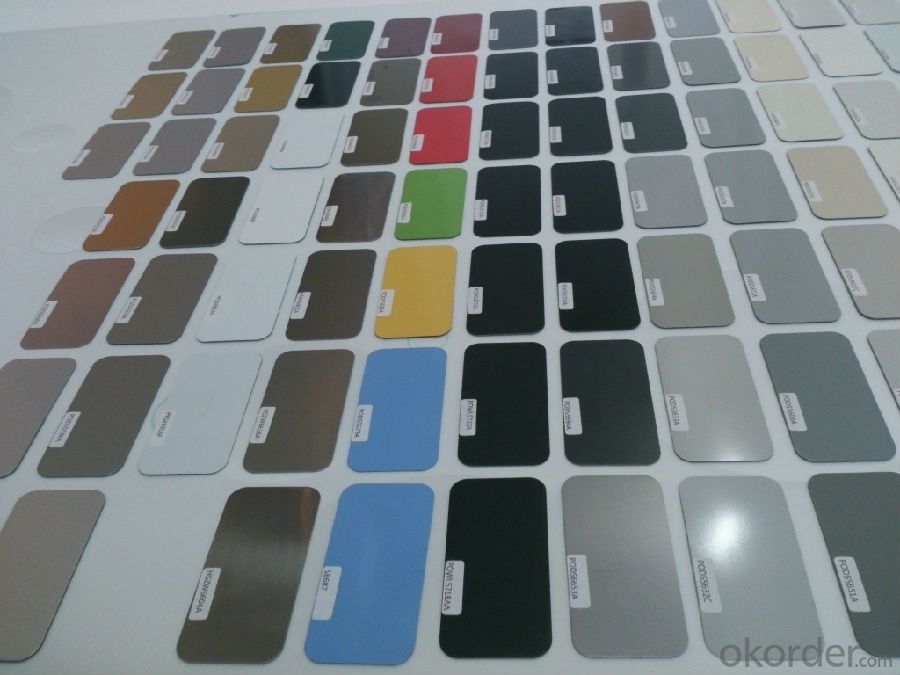
Description of Prime quality square alloy steel billet 95mm Q235
1. Prepainted steel coil is coated with organic layer, which provides higher anti-corrosion property and a longer lifespan than that of galvanized or galvalume steel sheets.
2. The base metals for prepainted steel coil consist of cold rolled, HDGI Steel, electro-galvanized and hot-dip alu-zinc coated steel. The finish coats of prepainted steel coil can be classified into groups as follows: polyester, silicon modified polyesters, polyvinylidene fluoride, high-durability polyester, etc.
3. The production process has evolved from one-coating-and-one-baking to double-coating-and-double-baking, and even three-coating-and-three-baking.
4. The color of the prepainted steel coil has a very wide selection, like orange, cream-colored, dark sky blue, sea blue, bright red, brick red, ivory white, porcelain blue, etc.
5. The prepainted steel coils can also be classified into groups by their surface textures, namely regular prepainted sheets, embossed sheets and printed sheets.

Main Feature of Prime quality square alloy steel billet 95mm Q235
Uncoated CR steel sheet
With the features of in line with the international highest standards in demension and shape, excellent surface finish and properties, the products are mainly used in home appliance and automobile industries.
Galvanized steel sheet(include HDG and EG)
With the features of good corrosion resistance, the products are mainly used in automobile, home appliance, electronics, building and machinery manufacture industries, etc.
Precoated steel sheet
With the features of enviromental protection and good processablility, long lasting surface durability, rich in colors, the products are maily used in building, home appliance and furniture industries, etc.
Applications of Prime quality square alloy steel billet 95mm Q235
Construction
Manufacture anticorrosion, industrial and civil architecture roof boarding, roof grille
Light industries
Home appliance's case, civil chimney, kitchen utensils
Auto industry
Corrosion resistant parts of cars
Agriculture
Food storage, meat and aquatic products' freezing and processing equipment
Commerce
Equipments to store and transport materials, and packing implements

Specifications of Prime quality square alloy steel billet 95mm Q235
Product | Prime quality square alloy steel billet 95mm Q235 |
Material Grade | SGCC / SGCH / DX51D+AZ, etc |
Thickness | 0.6-3.0mm |
Width | 500-1500mm |
Tolerance | Thickness: +/-0.02mm , Width:+/-2mm |
Zinc-coating | Z30-150g/m2 |
Technique | Raw material: Hot rolled steel coil --> Cold rolled_>hot dipped galvalume |
Surface | Dried, Chromated, Unoiled |
Spangle | Regular spangle , small spangle, zero spangle |
ID | 508MM 610MM |
Coil weight | 1-25MT |
Export package | Cardboard inner sleeves, Waterproof paper, galvanized steel covered and steel strip packed |
FAQ of Prime quality square alloy steel billet 95mm Q235
We have organized several common questions for our clients,may help you sincerely:
1. How Can I Visit There?
Our company is located in Tianjin City, China, near Beijing. You can fly to Tianjin Airport Directly. All our clients, from home or aboard, are warmly welcome to visit us!
2. How Can I Get Some Sample?
We are honored to offer you sample.
3. Why choose CNBM?
Our delivery time about 15-20days for standard sizes, if you have other requirements like hardness, quanity and width ,it is about 20-40days. But don't worry we also try our best for the delivery time ,because time longer and our cost is higher.
- Q: Are there any international standards for steel billets?
- Yes, there are international standards for steel billets. The most commonly recognized standards for steel billets include ASTM (American Society for Testing and Materials), BS (British Standards), and EN (European Standards). These standards ensure the quality, composition, and dimensions of steel billets, promoting consistency and compatibility in international trade and manufacturing processes.
- Q: How are steel billets used in the manufacturing of power plant equipment?
- Steel billets are an essential component in the manufacturing of power plant equipment due to their superior strength and durability. These billets serve as the raw material that is shaped and formed into various parts and components required for power plant machinery. One of the key applications of steel billets in power plant equipment manufacturing is in the production of turbine blades. These blades are subjected to high temperatures, extreme pressures, and rotational forces. Steel billets are carefully selected to possess the necessary mechanical properties, such as high tensile strength and resistance to corrosion and fatigue, ensuring the blades can withstand the demanding operating conditions. Moreover, steel billets are also used in the production of generator rotors and stators. These components are responsible for converting mechanical energy into electrical energy. The strength and stability of steel billets allow them to withstand the intense magnetic fields and rotational forces generated by the generator, ensuring reliable and efficient power generation. Furthermore, steel billets are utilized in the manufacturing of boilers and pressure vessels, which are crucial for the power generation process. These vessels are subjected to high pressures and temperatures, and steel billets with excellent heat resistance and pressure containment properties are employed to ensure the safety and reliability of the power plant equipment. In summary, steel billets are integral to the manufacturing of power plant equipment due to their superior strength, durability, and resistance to extreme conditions. Whether it is for turbine blades, generator components, or pressure vessels, steel billets play a crucial role in ensuring the reliable and efficient operation of power plants.
- Q: How are steel billets cast into shape?
- Steel billets are cast into shape using a process called continuous casting. This process involves pouring molten steel into a water-cooled copper mold, which is in the shape of a billet. As the steel is poured, it begins to solidify along the walls of the mold. At the bottom of the mold, a water spray is used to rapidly cool the steel, causing it to solidify completely. As the steel solidifies, it is continuously pulled out of the mold by a set of rollers or by a chain conveyor. Once the billet is completely solidified, it is cut into desired lengths using a high-speed torch or saw. These cut billets are then transported to the next stage of the steel manufacturing process, such as rolling or forging, where they are further shaped into the final desired product. Continuous casting allows for the production of steel billets with a consistent cross-sectional shape and size. This process is highly efficient and produces high-quality steel products with minimal waste.
- Q: What are the potential applications of steel billets in the medical sector?
- The medical sector has a wide range of potential applications for steel billets. One key use is in the manufacturing of medical instruments and surgical tools. Steel's high strength and durability make it an ideal material for producing precise and reliable instruments. Scalpels, forceps, bone saws, and orthopedic implants are just a few examples of the various medical tools that can be made from steel billets and are essential for surgeries and procedures. Moreover, steel billets can be utilized in the production of medical equipment like hospital beds, wheelchairs, and stretchers. These products require a strong and robust material to ensure patient safety and comfort. Steel provides the necessary strength to support the weight of patients and withstand regular usage, making it an excellent choice for these applications. Additionally, steel billets can be used in the construction of medical facilities and infrastructure. Steel is renowned for its structural integrity, making it suitable for building hospitals, clinics, and research laboratories. Steel structures offer resistance against earthquakes, fires, and other natural disasters, ensuring the safety of both medical personnel and patients. Furthermore, steel billets can be employed in the manufacturing of medical storage systems and cabinets. These storage solutions are crucial for maintaining a sterile and organized environment, preventing cross-contamination, and ensuring the proper storage of medical supplies and equipment. To sum up, steel billets have extensive potential in the medical sector. Steel's strength, durability, and reliability make it an invaluable material for enhancing patient care and safety, whether it's through the production of surgical instruments, medical equipment, construction of medical facilities, or manufacturing of medical storage solutions.
- Q: How do steel billets contribute to the manufacturing of marine equipment?
- The manufacturing of marine equipment relies heavily on steel billets, which serve as crucial materials. These semi-finished products are utilized in the production of multiple marine components, including ship hulls, propellers, shafts, and other structural parts. The exceptional strength and durability of steel billets make them highly preferred in the marine industry. Given the harsh conditions that ships and other marine equipment endure, such as extreme temperatures, corrosive saltwater, and heavy loads, steel billets, composed of top-quality steel, possess the necessary strength to withstand these challenging environments. This ensures the long-term reliability and safety of the equipment. Additionally, steel billets offer the flexibility needed in marine equipment manufacturing to create complex shapes and designs. By easily molding and forging the billets into desired shapes, intricate components with precise specifications can be produced. This versatility enables the manufacturing of different marine equipment parts that are vital for the efficient operation of vessels. Another advantage of using steel billets in marine equipment manufacturing is their resistance to corrosion. Through the application of various protective coatings or alloys, steel billets can enhance their resistance to corrosion caused by exposure to seawater. This corrosion resistance is critical in preserving the integrity and longevity of marine equipment, ensuring their ability to withstand the harsh marine environment for extended periods. Furthermore, steel billets offer excellent weldability, making them suitable for the construction and repair of marine equipment. The ability to weld steel billets together allows for the seamless joining of different components, ensuring structural integrity and reducing the risk of failure. This welding capability facilitates the assembly and maintenance of marine equipment, enabling efficient production processes and cost-effective repairs. In conclusion, the strength, durability, versatility, corrosion resistance, and weldability of steel billets make them indispensable in the manufacturing of marine equipment. These qualities establish steel billets as the preferred choice for producing various marine components, guaranteeing the reliability, safety, and longevity of the equipment in the demanding marine environment.
- Q: What are the main factors affecting the dimensional stability of steel billets?
- There are several main factors that can affect the dimensional stability of steel billets. 1. Temperature: One of the most significant factors is temperature. Steel billets can undergo thermal expansion or contraction depending on the temperature they are exposed to. Changes in temperature can cause the billets to expand or contract, leading to dimensional changes. It is crucial to control the temperature during the manufacturing process and subsequent cooling stages to minimize these effects. 2. Cooling rate: The rate at which the steel billets cool down after being heated also affects their dimensional stability. Rapid cooling can result in internal stresses within the billet, causing it to warp or distort. On the other hand, slow cooling can lead to uneven cooling and uneven dimensional changes. 3. Composition: The chemical composition of the steel billets plays a significant role in their dimensional stability. Different alloying elements, impurities, and carbon content can influence the material's behavior during heating and cooling. For instance, higher carbon content can increase the likelihood of warping or distortion. 4. Mechanical stresses: Mechanical stresses from handling, transportation, or machining processes can impact the dimensional stability of steel billets. Excessive bending, twisting, or pressure can cause permanent deformation or residual stresses within the billet, affecting its overall dimensional stability. 5. Heat treatment: The heat treatment process can also influence the dimensional stability of steel billets. Different heat treatment methods, such as annealing, quenching, or tempering, can introduce internal stresses or phase transformations that may alter the billet's dimensions. 6. Manufacturing techniques: The processes used during the production of steel billets, such as casting, rolling, or forging, can have an impact on their dimensional stability. Inadequate control or inconsistencies in these manufacturing techniques can lead to variations in the billet's dimensions. It is crucial to consider and control these factors to ensure the dimensional stability of steel billets, as any dimensional changes can affect the subsequent processing steps and the final product's quality.
- Q: What are the different surface finishes available for steel billets?
- Steel billets can be finished in several different ways, depending on their specific requirements and intended use. Some commonly used surface finishes include: 1. Hot Rolled: Steel billets are rolled at high temperatures, resulting in a rough and scaled surface. This finish is suitable for applications where aesthetics are not a priority. 2. Cold Rolled: Steel billets are rolled at room temperature to achieve a smoother and more polished surface. Cold rolling improves dimensional accuracy and surface quality. 3. Pickled and Oiled: Scale and rust are removed from the steel billets using an acid solution, followed by an oil coating to prevent corrosion. This finish provides a clean and rust-free surface, commonly used in the automotive and construction industries. 4. Galvanized: A zinc coating is applied to the steel billets to protect them from corrosion. This finish offers excellent corrosion resistance, making it suitable for outdoor applications like fencing, roofing, and structural components. 5. Passivated: Free iron is removed from the steel surface through a chemical process, enhancing its corrosion resistance. This finish is often used in the production of stainless steel billets to improve their resistance to rust and other forms of corrosion. 6. Shot Blasting: Small abrasive particles are projected onto the steel billets' surface to remove scale, rust, and impurities. This process creates a textured and uniform finish, ideal for applications requiring improved adhesion, such as painting or coating. 7. Polished: Abrasive materials are used to smoothen the surface of steel billets and achieve a high-gloss finish. This finish is commonly used for decorative purposes in furniture, architectural components, and jewelry. It's important to consider various factors, such as the intended application, desired aesthetics, and required corrosion resistance, when choosing a surface finish for steel billets.
- Q: What are the properties and characteristics of steel billets?
- Steel billets, typically utilized in the production of various steel products, exhibit numerous properties and characteristics that render them suitable for such applications. To begin with, their exceptional strength-to-weight ratio endows steel billets with immense strength, enabling them to withstand heavy loads. This strength is derived from the steel's carbon content, which enhances its structural integrity. Furthermore, their superb heat conductivity facilitates efficient heat transfer during diverse manufacturing processes. Consequently, steel billets prove ideal for applications involving high-temperature operations, such as forging and rolling. Moreover, their remarkable machinability enables easy shaping and forming into desired products. This property is of utmost importance in the manufacturing industry, as it allows for the production of intricate and personalized steel components. Steel billets also possess outstanding ductility, enabling them to stretch and mold without fracturing. This characteristic proves vital in applications requiring bending or forming the steel into various shapes. In addition, steel billets exhibit a high resistance to corrosion, rendering them suitable for outdoor or corrosive environments. This property guarantees the durability and longevity of steel products manufactured from billets. Furthermore, steel billets can be effortlessly welded, facilitating the fabrication of large and intricate structures. Their weldability renders them versatile and adaptable to diverse construction and manufacturing needs. Lastly, steel billets boast a consistent and uniform composition, ensuring the production of high-quality and dependable steel products. This consistency is achieved through meticulous manufacturing processes and rigorous quality control measures. To conclude, steel billets possess numerous properties and characteristics that make them highly sought-after in the production of steel products. Their high strength, heat conductivity, machinability, ductility, corrosion resistance, weldability, and consistent composition deem them indispensable in various industries, including construction, automotive, and manufacturing.
- Q: What are the main factors affecting the hardenability of stainless steel billets?
- The main factors affecting the hardenability of stainless steel billets are the chemical composition of the steel, the cooling rate during heat treatment, and the presence of alloying elements such as chromium, nickel, and molybdenum. The chemical composition determines the steel's ability to form martensite, a hard and brittle phase, during quenching. The cooling rate influences the transformation of austenite, the high-temperature phase, into martensite. Alloying elements enhance the hardenability by promoting the formation of martensite and improving the steel's ability to retain its hardness upon cooling.
- Q: How do steel billets contribute to the manufacturing of industrial machinery?
- The manufacturing of industrial machinery heavily relies on steel billets, which are semi-finished steel products molded into specific shapes and sizes. These billets serve as the raw material for producing various components and parts used in industrial machinery. To begin with, steel billets provide the necessary strength and durability required by industrial machinery. The high tensile strength and toughness of steel make it an ideal choice for withstanding heavy loads, vibrations, and extreme conditions that machinery often faces. By utilizing steel billets, manufacturers can ensure that the machinery they produce is capable of enduring these demanding conditions, thus increasing its reliability and longevity. Additionally, steel billets can be easily molded and shaped into different forms, allowing for the production of intricate and complex components. Precision-engineered parts tailored to specific functions and applications are often necessary for industrial machinery. Steel billets can be cast or forged into these intricate shapes, guaranteeing that the machinery operates with optimal efficiency and accuracy. Furthermore, steel billets possess excellent machinability, meaning they can be easily cut, drilled, and shaped using various machining techniques. This capability enables the creation of intricate details and tolerances required for the precise functioning of industrial machinery. The ability to machine steel billets with precision grants manufacturers the opportunity to produce components that fit together seamlessly, minimizing any potential performance issues. Moreover, steel billets offer a cost-effective solution for manufacturing industrial machinery. Steel is readily available and relatively inexpensive compared to other materials. Its superior strength-to-weight ratio also allows manufacturers to design lighter machinery without compromising its structural integrity. This reduction in manufacturing costs also makes the machinery more portable and easier to transport. Furthermore, steel billets provide excellent corrosion resistance, which is vital for industrial machinery operating in harsh environments. The protective oxide layer that forms on the surface of steel billets helps prevent rust and corrosion, ensuring that the machinery remains in optimal working condition even in challenging situations. In conclusion, the strength, durability, machinability, cost-effectiveness, and corrosion resistance offered by steel billets make them essential in the manufacturing of industrial machinery. These properties enable manufacturers to produce reliable, precise, and long-lasting machinery capable of withstanding demanding industrial applications.
Send your message to us
Prime quality square alloy steel billet 90mm Q235
- Loading Port:
- Tianjin
- Payment Terms:
- TT OR LC
- Min Order Qty:
- 100 m.t.
- Supply Capability:
- 10000 m.t./month
OKorder Service Pledge
OKorder Financial Service
Similar products
Hot products
Hot Searches
Related keywords
